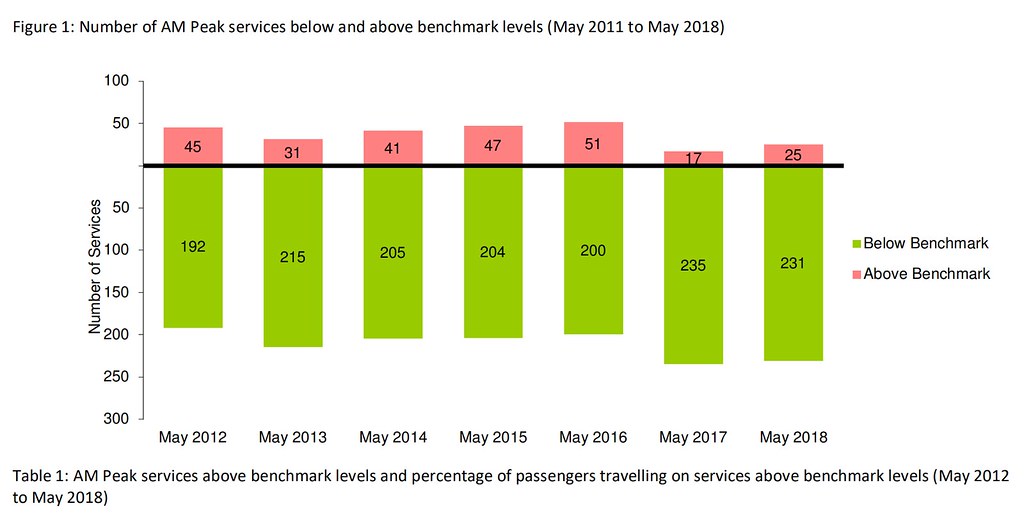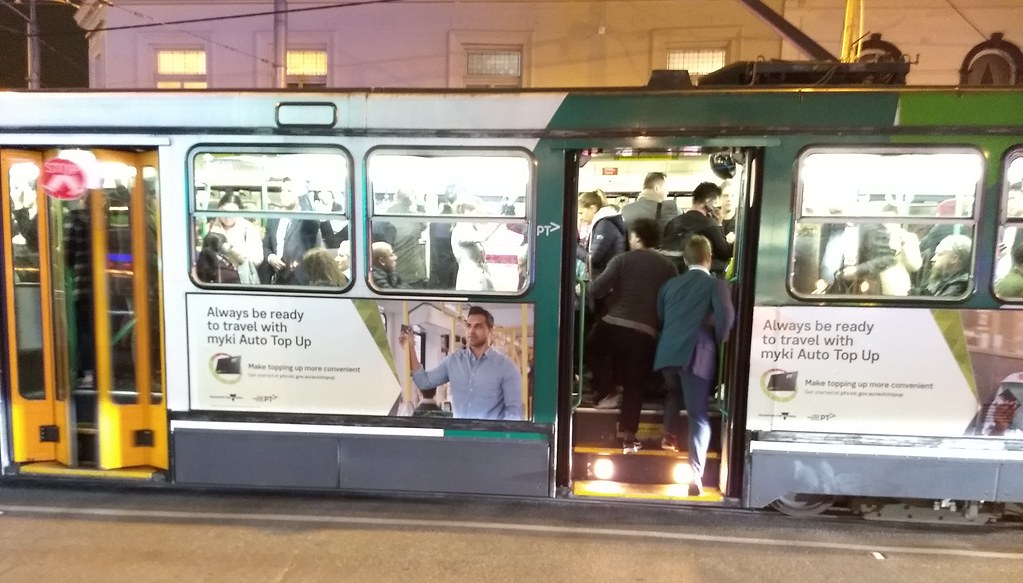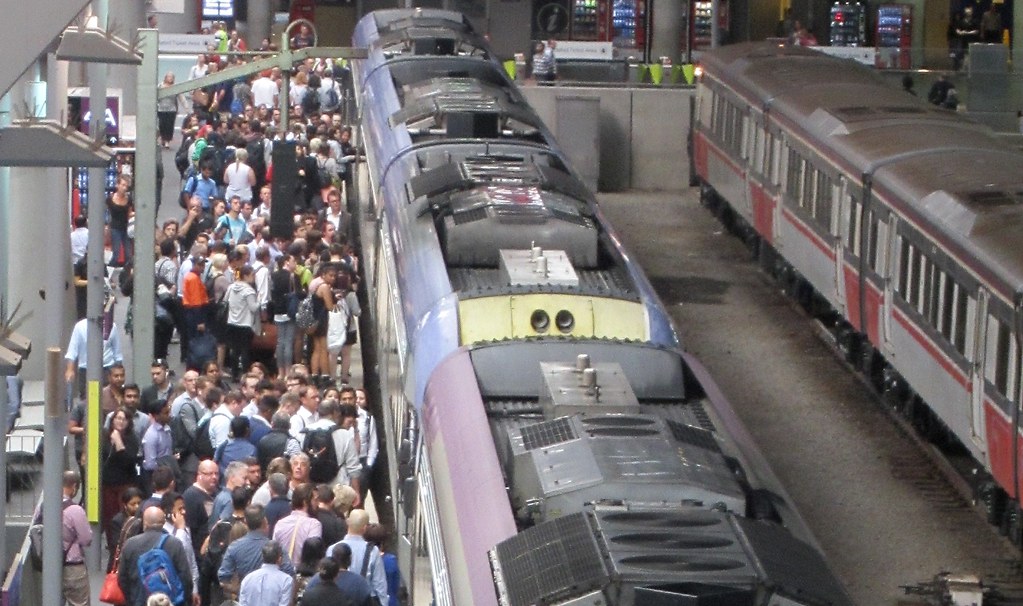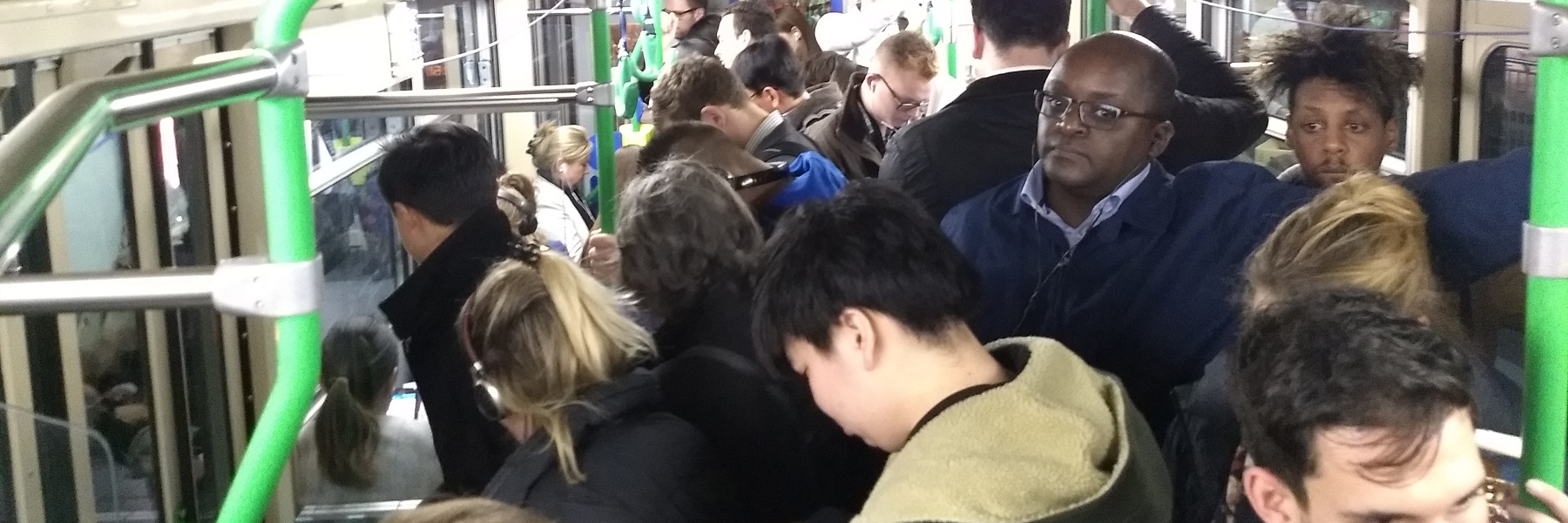The May 2018 Metro and Yarra Trams passenger load surveys were released last week.
Media coverage: Herald Sun (paywall); The Age
It’s worth noting that load surveys are measuring what happens when the service is running as planned. It’s not designed to look at crowding during disruptions, it’s designed to guide future investment.
Trains
Here’s the TL;DR for Metro: After a reduction in the past couple of years, crowding is on the rise again. 9.8% of AM services are above the threshold, and 4.8% of PM services.
To me, this indicates that patronage has kept increasing, and the reduction in crowding in 2017 was thanks to the removal of some seats to increase standing space. Unfortunately on some lines there hasn’t been a huge number of new services added to the peak timetable in some years — only 5 across the networkwide AM peak between May 2015 and May 2018 according to the graph.

Here’s a summary of the state of the lines. Rather than use the figures concerning the number of trains that are overcrowded, I’ve pulled out the percentage of peak passengers travelling on overcrowded trains:
| Line | AM peak | PM peak | Notes |
|---|---|---|---|
| Alamein | 0.0% | 0.0% | Steady since 2012 |
| Glen Waverley | 0.0% | 16.6% | Crowding increasing |
| Ringwood | 7.4% | 6.8% | Crowding increasing marginally in AM peak |
| Dandenong | 16.8% | 10.8% | Crowding dropped markedly from 2016 to 2017, but is on the rise again |
| Frankston | 16.1% | 5.3% | AM peak has been consistently more crowded since 2012. Dropped between 2015 and 2017, but rising again |
| Sandringham | 0.0% | 0.0% | In the past has been consistently more crowded in AM peak, but has improved a lot since 2016. |
| South Morang | 24.0% | 27.2% | This survey was before the Mernda extension opened, though that added extra services: AM peak increased from 15 trains in May to 20 now. |
| Hurstbridge | 22.1% | 0.0% | Increased crowding in AM peak. Continued duplication of the line will help run extra trains. |
| Craigieburn | 23.6% | 10.7% | Peaked in 2016 and has been dropping, but clearly still very crowded |
| Sunbury | 18.4% | 0.0% | Peaked in 2016 but has improved… for now. |
| Upfield | 0.0% | 0.0% | Crowding has dropped since 2016 despite no extra services; not really clear why. (The AM peak switch from 20 minute frequencies to 18 minutes was in 2012.) |
| Werribee | 17.6% | 5.7% | Similar to the Dandenong line; crowding had been improving, but has increased recently |
| Williamstown | 0.0% | 0.0% | As with Alamein, no crowding recorded since 2012 |
Basically, crowding on the lines serving the growth areas of Melbourne (especially Sunbury, Dandenong, Werribee and South Morang/Mernda) can be expected to worsen over coming years if nothing is done.
Also worth noting: the focus is on peak hours, but there are now real problems outside peak hours, including weekends. Some lines run as little as every 40 minutes on Sunday mornings, and are packed. This should be an easy win to fix, but seems to be a blind spot for the government.
The load survey notes say that counts are actually done between 6am and midday, and 2pm and 7pm. It’d be interesting to see the data from the middle of the day, when some lines see a big service frequency reduction.

Trams
Tram crowding has also worsened, with load breaches primarily on Swanston Street/St Kilda Road, and Elgin/Lygon Street (routes 1 and 6), particularly in the morning peak.
Other hotspots in the AM peak include Wellington Parade (routes 48/75 — I’m betting mostly the 48, which usually uses small trams), and on Clarendon Street (route 12, another with small trams).
And there’s a twist: for the first time, they measured a “non-cordon” (eg non-CBD) location: route 82 at Droop Street and Ballarat Road — and found that too is overcrowded in the AM peak.
Perhaps this should be no surprise: despite huge urban renewal around Maribyrnong, this route is one of the least frequent in Melbourne (only every 15 minutes in peak) and runs all small trams.

Decentralisation?
One can understand where the debate about population and decentralisation is coming from – prompting talk of (among other things) fast rail to the regions.
But if decentralisation just means fewer people moving into Melbourne (which at least has some semblance of a public transport network) and more moving into regional areas (many of which really don’t have any public transport, apart from a small number of buses and trains) then that’s not a good outcome. It just means more car dependence and sprawl in towns around the state.
Plus our local decision makers haven’t yet learnt that big cities can and do deal with congestion… just not by building more motorways. They can’t necessarily eliminate congestion, but they can ensure that more people can get around without being caught in it, by providing alternatives to driving.
Can PT cope?
You can argue that public transport in Melbourne and Sydney isn’t coping with our growing population.
But it’s incorrect to claim it can’t cope… because we haven’t really tried.
- Australia has no metro systems (Sydney’s one line under construction doesn’t make a system) — frequent services all day until midnight, with dedicated routes? Suburban rail can transition to it, but it’s a frustratingly slow process
- There’s almost no proper light rail with real on-road and traffic light priority — the Gold Coast is the only example in the nation.
- Frequent buses with priority? Very rare. Brisbane is perhaps the only city doing this seriously, and even there the busways are arguably doing the job that should be done by trains.
Meanwhile, Melbourne’s recently opened major rail projects were very welcome, but:
- Tarneit/Wyndham Vale/Caroline Springs/Melton etc need a metro or a suburban service, but got a regional train service which is predictably struggling
- Mernda got a “Metro” connection that runs as little as every 30-40 minutes
None of this is good enough in a city of 5 million people and growing.

While successive Victorian governments haven’t really tried in a serious way to fund high frequency high capacity public transport, they’ve tried everything they can to get the motorways to cater for growth.
More and more lanes, “managed motorways” (metering aka traffic lights, dynamic speed limits, automated lane signage).
It doesn’t work. Ultimately, moving millions of people around in their own metal boxes simply doesn’t work… which is why the smartest big cities have fewer motorways than we do.
The time has come for proper, turn-up-and-go, big city public transport. Our government must do better.
- On Wednesday I participated in a forum on ABC Radio. The full audio is here. Transport is the middle section, but the whole thing (also covering housing and crime) is worth a listen.

14 replies on “PT crowding increasing – but we can do better”
Would also like to point out to that Sydney is building the second metro line, Metro West, as well which will open in the late 2020s. A third metro line will also likely open in the late 2020s as well between St Marys and the new airport, they picked metro as the mode for the line for some reason but it’ll form part of a larger 60-70km North-South metro link. Sydney also has more lines under consideration as part of the Future Transport plan. Speaking of bus priority, the Transitways (T-way) in Western Sydney work pretty well too, there are bus-only lanes for the entire way on the T80 and T65 and there are a few bus-only grade separations too, mostly flyovers, cars have to use the normal intersection. It’s a shame they gave up on it.
With all that Sydney stuff said, the Metro Tunnel should be capable of high frequencies during the off-peak. Metro style headways of 5-8 minutes between Sunshine and Dandenong (10-15 minutes on the branches counting Melton too) is easily achievable and there’s no reason why it shouldn’t happen. And isn’t what you call “Metro 3” (SRL) going to be a real metro? You could also build Metro 2 as a proper metro (Metro 1 has sailed). Just convert the Mernda and Werribee lines to a proper metro, like what Sydney is doing. Mernda doesn’t have freight so that’s easy and Werribee has lots of space in the rail corridor to build 4 tracks to separate the freight/mainline and proper metro services with a pair of tracks each. And no branching makes it a bit simpler to build it as a proper metro too. Another potential line is the “Metro 3” proposal from Melbourne City Council which would connect the Airport to Doncaster. The airport line is under planning now but I can see how it in the future to form part of a proper metro.
> The May 2018 Metro and Yarra Trams passenger load surveys were released last week.
Is there a reason that one of the three public transport modes is not surveyed at all?
I’ve been following how this is going for some time and unfortunately I’m quite pessimistic. A lot of what you’ve talked about here is fairly straightforward, and should be evident to the engineers, planners and public servants – but it isn’t happening.
Somewhere along the line there is a failure to actually measure and work towards meaningful outcomes – such as improving access and mobility, decreasing the transportation costs to the economy etc. The focus is on outputs – building a projects or ‘things’ – but specifically working towards a desired set out of outcomes. This indicates that the department is incompetent, or because of political or commercial intervention the processes is not working.
Regional Rail Link is a case in point – infrastructure was delivered – but how many additional Metro/VLine services have been delivered as a result of it? Has reliability and access to and from regional areas improved? Why haven’t the additional peak and off-peak slots been used? Just constructing railway stations and track is not a success, if the whole point of the project was to improve transport in the western suburbs, and on the western V/Line lines.
The level crossing removals are popular, that is sure, but the Auditor-General’s report shows that the authority is failing to actually measure meaningful outcomes, and that is has not even figured out what it is trying to do. Is it trying to ease traffic? They have not been measuring this properly – how much traffic does it need to ease to be worth the cost. Is it enabling new trains? How many and when? When the Caulfield-Dandenong crossings were completed, no additional services were added resulting directly from it (some were added late at night, but they were always possible), so what is the actual outcome? They extended the train to Mernda, but how much will it improve access, given it takes an eternity to reach the city, frequencies are poor, services are overcrowded and connecting buses are poor. Would having also provided a higher level of service provided a much greater impact to the outcomes?
Some other projects also reek of this – major tollway projects in particular. The projects are done for ‘the sake of the project’, the outcomes, justifications and economic assessments are fished up after it is decided that they will be done. A lot of people always seem to have the perverse opinion that screw the cost – we just need to do it – “because”, forgetting that they are literally the ones that will be paying for it. It is all our money after all, and the decisions made about how it is spent much we get back out of it.
It is not just about the specific projects and funding etc., it is a much larger problem, and that is quite daunting.
What an archaic process of observers with clipboards, followed by 4 months to manually process the data ! One of the supposed benefits of myki was the better statistics of where and when people are actually travelling. Was there a botched contract process, so that after 10 years of myki we’re still not getting out these statistics and instead having to employ manual observers with clipboards? What the system should be able to provide is the loading of each train, tram and bus service by the start of the following day (after all journeys have tagged off). These stats would enable better service planning by the operators, ptv and the government, and summaries should be available on the ptv website, just as the “crowding” data are available on the V-line website. Instead we get this long lag period between observations in May and service planning decisions by perhaps the following March. Furthermore there are no publicly available data on off-peak patronage and potential crowding. When will ptv deliver on the promise made 10 years ago when myki was introduced?
Glen Waverley PM more crowded than AM. No surprise there. The former runs approx. every 12 minutes and is subject to being affected by other lines using the city loop. The latter runs relatively separate to other lines direct to/from Flinders St approx. every 7 minutes.
Actually, I might say Sydney seems to be coping in some aspects – at least the Government there seem to be investing in more public transport. At least one new light rail route is well under way (though not without controversy), with another being lined up for construction for the start of 2019. I think most of the trains in the inner city is 15 mins around the clock too. There’s also another metro line in Sydney under planning and investigation – although it’s still too early to say if that will go ahead. Finally, I notice that, since from back in 2012, Sydney’s existing trains seemed to be more reliable than Melbourne’s, though I will need to get back with some hard data, as my experiences were in 2012-present and 2006-2011 (I used to study in Melbourne.) respectively.
Of course, it could do better. There are still a lot of areas without suitable bike lanes for starters (though the hilly terrain probably does not help), and chronic overcrowdings at Town Hall and Redfern Stations – especially with the latter overdue for a station expansion. Not to mention still a lot of suburbs without suitable rail lines etc. There is still a lot of investment on freeways as well, such as Westconnex.
Interesting to see that crowding on the Werribee line is increasing. This is not a surprise, there is massive growth occurring there. Residents can have a choice of 2 lines to use if they want to drive to a station: either the metro Werribee line or the Regional Rail Link into CBD (new stations at Wyndhamvale and Tarneit).
Ironically, many of the level crossings on the (metro) Werribee line that were given some priority by VicRoads in their 2014 report are NOT on the ALP list of top 50 to be removed. Yet instead there are “No Priority” stations at Ferguson St Williamstown (Williamstown line) and Kororoit Creek Rd North Williamstown (Altona line) both on the list. Which is evidence that the Level Crossing Removal Program was more about the ALP ‘ticking boxes’ with quick, easy xings, than a more strategic focus on public transport benefits and really making a dint in congestion on our roads.
The ALP recently announced 35 new services on the Werribee line. It’s hard to see that these services will not cause huge problems at xings such as Hoppers Crossing (also not on the list) – which is also close to the Mercy Hospital and requires emergency access.
Also interesting to see no statistics for the Altona line? Why is this missing? It is regularly bypassed by Metro by the way, so despite the ALP spending 82 million on removing the ‘no priority’ level crossing at Kororoit Creek Rd there is no improvement in the reliability of the train service on the Altona line.
Reply to Cam: I agree with your comments, especially regarding the level crossing program. The Auditor-General’s report last December (nice timing, it came out just before Christmas, buried or what!!) was quite critical of the Program. Yes crossing removals seem popular in some quarters, abhorred in others where the outcome has been quite imposing (skyrail) or has simply made the area more dangerous for vulnerable users (eg. Buckley St Essendon, no cyclist lane in the new road under the tracks, despite it being on the Principal Bicylce Network. The Govt ‘solution’ was to remove Buckley St from the PBN!!). Agree that xing removals have also not led to an increase in train services, so a lost opportunity there. AND the congestion benefits are next to zip. See the results of the LXRA’s own post-removal surveys. In ALL cases, there was MORE traffic and only minor travel time savings of less than a minute. Billions have been wasted, the Program desperately needs to be reviewed/better targeted.
If Sydney has more lines under construction, it is because the LNP Government in Canberra has decided to throw money at them, while restricting what it gives Melbourne.
None of which excuses the Andrews Government’s failure to run regular services on the lines it does have. It’s also worth restating that most of the tram fleet is illegal and does not comply with the Disability Discrimination Act, and only operates under a dubious carve-out which was meant to be temporary. Replacing these would rectify a few faults.
Ask anyone in Adelaide who uses their “O-Bahn” bus route from Modbury to the city whether they’d prefer a train, tram or their O-Bahn bus way. Guaranteed the answer will be the Busway. This system has been in place for over 30 years and is the most flexible and speedy transit system in Adelaide. Developed in Germany over 40 years ago to enable buses and trams to use the same right-of-way and being a fraction of the cost of laying heavy or light rail, yet able to use their dedicated Busway tracks (an actual guided track for buses where there is no need for the driver to steer the vehicle). Psychologically, transit passengers prefer a “guided track” (usually railway) rather than having a driver steer the vehicle and the risks of collision that go with that). For anyone not familiar with a guided Busway, Google it (Adelaide O-Bahn, or guided Busway). The flexibility of entering and leaving the guided busway from regular roadways without even slowing down is another aspect that passengers appreciate when using a guided busway. Having lived in Adelaide and used their O-Bahn, I tend to agree wholeheartedly with proponents of their wonderful system. It works so well in places of low to medium population density and as stated before, is much cheaper to build and maintain than heavy or light rail. There are so many potential routes in Australian cities where this could work exceedingly well. Can’t work out for the life of me why the concept is not used widely in Australia.
The Werribee line had both extra peak trains (1 in each peak, a third of trains added (which is ridiculous considering that the survey covers some peak shoulder times that have plenty o space for extra services)) and the extension of the inter-peak Altona loop services too Flinders St, with accompanying conversion of inter-peak Werribee services to express services (1 train moved earlier into the morning peak and 4 in the afternoon peak (the extended services are in the earlier part of the evening peak/peak shoulder)) providing greater capacity and faster travel for peak shoulder and other inter-peak passengers (unless they travel between Laverton-Werribee and one of the stations expressed through).
The survey also fails to collect any counter-peak data on the Ringwood/Alamein corridor, which is quite busy in parts of peak because of office workers (mainly East Richmond, Box Hill etc) and uni students (mainly Glenferrie).
Hi Daniel, I am a long term train and tram user but only new to the public transport industry.
I attended a presentation by Vic Bus Assoc and Monash Uni last week which talked through lots of issues affecting public transport and buses.
Did you attend?
I have read quite a few articles on your blog and there seem to be some announcements regarding more trains but many are pre-election announcements.
In a meeting today with V-Line they had some reservation about what a Liberal Govt might do to public transport and regional trains. As a public transport user, I have not heard much from them (or don’t recall much).
Do you have an opinion on this?
[…] often delayed and overcrowded, and that’s partly due to the […]
Looking at your table – did they not have any statistics about the Cranbourne and Pakenham lines beyond Dandenong?